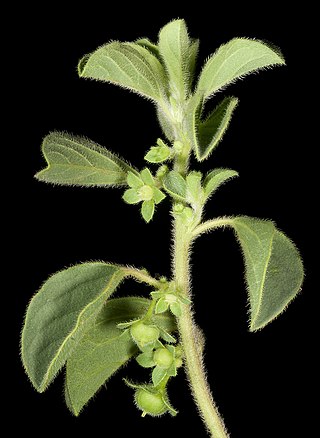Top Qs
Timeline
Chat
Perspective
Notoleptopus
Genus of flowering plants From Wikipedia, the free encyclopedia
Remove ads
Notoleptopus is a monotypic genus of flowering plants in the family Phyllanthaceae. It is one of eight genera in the tribe Poranthereae. The sole species is Notoleptopus decaisnei. It is a monoecious shrub, native to Australia, New Guinea, and Indonesia.
Notoleptopus decaisnei had long been treated as a species of Leptopus, but in 2007, a molecular phylogenetic study of DNA sequences found it to be sister to a clade consisting of Pseudophyllanthus and Poranthera.[1] In 2008, the new genus Notoleptopus was created for it.[2]
The species, N. decaisnei, has eleven synonyms,[3] and was first described as Andrachne decaisnei by George Bentham in 1873.[4][5] The species epithet honours Joseph Decaisne.
- Andrachne decaisnei Benth.
- Andrachne decaisnei var. orbicularis Benth.
- Andrachne fruticosa Decne. ex Müll.Arg.
- Andrachne fruticosa var. orbicularis (Benth.) Pax & K.Hoffm.
- Andrachne orbicularis (Benth.) Domin
- Arachne decaisnei (Benth.) Pojark.
- Arachne fruticosa Hurus.
- Arachne orbicularis (Benth.) Pojark.
- Leptopus decaisnei (Benth.) Pojark.
- Leptopus decaisnei var. orbicularis (Benth.) Airy Shaw
- Leptopus orbicularis (Benth.) Pojark.
Remove ads
Description
Bentham describes the species Andrachne Decaisnei as follows:
Apparently annual, but the stems hard and woody-looking at the base, much branched, decumbent, attaining 1 to 2 or even 3 ft., the whole plant softly villous. Leaves broadly obovate or obovate-oblong, ½ to ¾ in. long, on rather long petioles. Male flowers 2 or 3 together on very short pedicels. Calyx-segments 5, lanceolate, acute, spreading, about ½ line long. Petals narrow, nearly as long as the calyx. Female flowers solitary in the same axils as the males, on pedicels attaining 1 line when in fruit. Calyx-segments under the fruit broadly ovate, fully 1 line long, the base of the calyx contracted into a distinct stipes. Styles divided to the base into 2 branches. Capsule depressed, orbicular, villous, about 2 lines diameter.[5]
In Australia, it is found in Western Australia, the Northern Territory and Queensland.[3] In Queensland, under the Nature Conservation Act 1992, it is declared a species of "least concern".[6]
Remove ads
References
External links
Wikiwand - on
Seamless Wikipedia browsing. On steroids.
Remove ads

